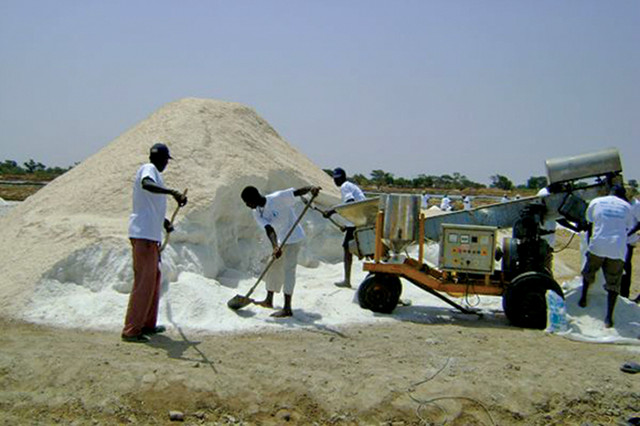
by U.S. Geological Survey Friday, September 18, 2015
Emily K. Schnebele, a mineral commodity specialist for the U.S. Geological Survey, compiled the following information on iodine, which is primarily used in X-ray contrast media, pharmaceuticals, disinfectants and LCD screens.

Iodine-depleted soils underlie some of the world's most populated areas, leaving many at risk of iodine deficiency. Its consequences, including goiter, are combated with salt iodization programs like this one sponsored by the U.N. World Food Program in Senegal in West Africa. Credit: WFP/Isabelle Dia.
Iodine is a bluish-black lustrous solid (violet-colored in its gaseous state) found primarily in seaweed, underground brines associated with petroleum deposits and caliche ore deposits.
Iodine is an essential element that enables the thyroid gland to produce thyroid hormones. Iodine deficiency, a world health problem affecting approximately 2 billion people, can cause goiter — enlargement of the thyroid gland — in adults, increased mortality and impaired cognitive development in children, and reproductive failure. Since the 1920s, iodized salt has been the primary source of supplemental dietary iodine in the Western world. Only two ounces of potassium iodate are required to iodize one ton of salt.
Globally, X-ray contrast media are the leading uses for iodine. X-ray contrast media are injected or swallowed by a patient to temporarily block the ability of X-rays to pass through soft tissues, blood vessels and organs, making them visible on X-rays. Other forms of iodine for medical uses include potassium iodide, which is used as an expectorant in cough medicine, and hydriodic acid and potassium iodide, which are used in the synthesis of amphetamine, ethylamphetamine and methamphetamine. Because iodine is one of the most effective medical antiseptics available, it is often used in biocides and disinfecting chemicals. Iodophors, water-soluble chemical complexes designed to carry large amounts of iodine, are incorporated into disinfectants for use in dairies, food processing plants, hospitals and laboratories.
A growing application for iodine is in the manufacture of iodine-adsorbed polyvinyl alcohol polarizing films for liquid crystal displays (LCDs) for electronic equipment, including appliances, computers, digital cameras, personal handheld devices and televisions. Polarizers are added to LCDs to enhance the light contrast between the screen and the liquid crystals, making the LCD more visible.
Future growth in iodine consumption likely will be driven by applications for X-ray contrast media and LCD screens, especially in developing countries. Expanding treatment of municipal water supplies could increase the demand for iodine-treated biocides and disinfectants in the future.
For more information on iodine and other mineral resources, visit http://minerals.er.usgs.gov/minerals.
World production of iodine in 2014 was estimated to be 30,300 metric tons (not including production data from the United States, which was withheld). Chile is the leading producer, accounting for about 20,000 metric tons per year. Japan ranks second with about 9,500 metric tons per year, and the U.S. ranks third.
In the United States, iodine is recovered primarily from brine wells in Oklahoma, with three companies accounting for all domestic iodine production.
Iodine was discovered by Bernard Courtois in 1811 in France and named for the Greek word “iodes,” meaning violet, the color of iodine vapor.
In 1924, the Morton Salt Company began distributing iodized salt throughout the United States.
The U.S. Recommended Daily Allowance (RDA) of iodine for adults is 150 micrograms per day. It would take about 3 million RDA doses to equal half a kilogram of iodine.
© 2008-2021. All rights reserved. Any copying, redistribution or retransmission of any of the contents of this service without the expressed written permission of the American Geosciences Institute is expressly prohibited. Click here for all copyright requests.